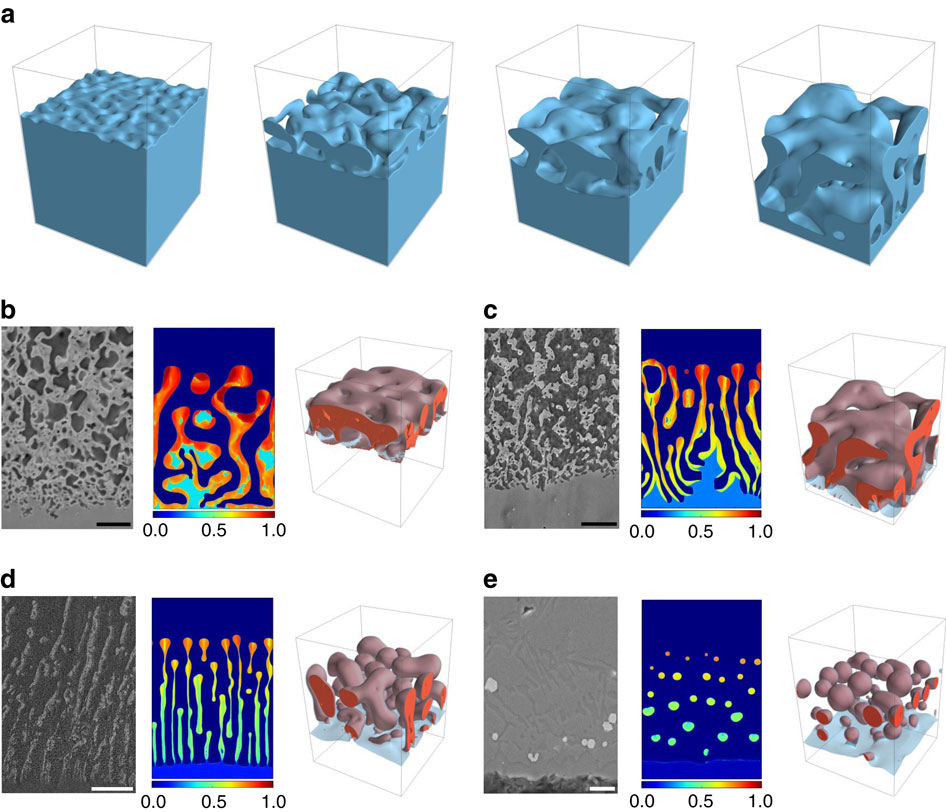当前位置:
X-MOL 学术
›
Nat. Commun.
›
论文详情
Our official English website, www.x-mol.net, welcomes your
feedback! (Note: you will need to create a separate account there.)
Topology-generating interfacial pattern formation during liquid metal dealloying.
Nature Communications ( IF 14.7 ) Pub Date : 2015-Nov-19 , DOI: 10.1038/ncomms9887 Pierre-Antoine Geslin , Ian McCue , Bernard Gaskey , Jonah Erlebacher , Alain Karma
Nature Communications ( IF 14.7 ) Pub Date : 2015-Nov-19 , DOI: 10.1038/ncomms9887 Pierre-Antoine Geslin , Ian McCue , Bernard Gaskey , Jonah Erlebacher , Alain Karma

|
Liquid metal dealloying has emerged as a novel technique to produce topologically complex nanoporous and nanocomposite structures with ultra-high interfacial area and other unique properties relevant for diverse material applications. This process is empirically known to require the selective dissolution of one element of a multicomponent solid alloy into a liquid metal to obtain desirable structures. However, how structures form is not known. Here we demonstrate, using mesoscale phase-field modelling and experiments, that nano/microstructural pattern formation during dealloying results from the interplay of (i) interfacial spinodal decomposition, forming compositional domain structures enriched in the immiscible element, and (ii) diffusion-coupled growth of the enriched solid phase and the liquid phase into the alloy. We highlight how those two basic mechanisms interact to yield a rich variety of topologically disconnected and connected structures. Moreover, we deduce scaling laws governing microstructural length scales and dealloying kinetics.
中文翻译:

液态金属脱合金过程中产生拓扑的界面图案形成。
液态金属脱合金已成为一种生产拓扑结构复杂的纳米多孔和纳米复合结构的新技术,该结构具有超高的界面面积和其他与多种材料应用相关的独特特性。根据经验已知该方法需要将多组分固体合金的一种元素选择性地溶解在液态金属中以获得所需的结构。但是,结构的形成方式尚不清楚。在这里,我们使用中尺度相场建模和实验证明了脱合金过程中纳米/微观结构的形成是由于(i)界面旋节线分解,形成富含不溶混元素的组成域结构和(ii)扩散耦合的相互作用富集的固相和液相生长到合金中。我们重点介绍了这两种基本机制如何相互作用以产生各种各样的拓扑结构断开和连接的结构。此外,我们推导了控制微观结构长度尺度和脱合金动力学的尺度定律。
更新日期:2015-11-22
中文翻译:

液态金属脱合金过程中产生拓扑的界面图案形成。
液态金属脱合金已成为一种生产拓扑结构复杂的纳米多孔和纳米复合结构的新技术,该结构具有超高的界面面积和其他与多种材料应用相关的独特特性。根据经验已知该方法需要将多组分固体合金的一种元素选择性地溶解在液态金属中以获得所需的结构。但是,结构的形成方式尚不清楚。在这里,我们使用中尺度相场建模和实验证明了脱合金过程中纳米/微观结构的形成是由于(i)界面旋节线分解,形成富含不溶混元素的组成域结构和(ii)扩散耦合的相互作用富集的固相和液相生长到合金中。我们重点介绍了这两种基本机制如何相互作用以产生各种各样的拓扑结构断开和连接的结构。此外,我们推导了控制微观结构长度尺度和脱合金动力学的尺度定律。































 京公网安备 11010802027423号
京公网安备 11010802027423号